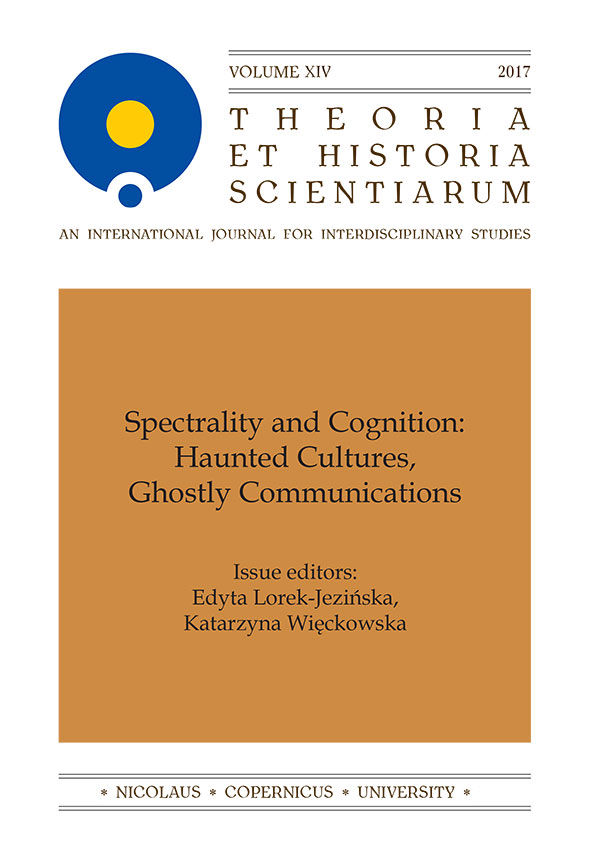Walking through the Past: The Mechanics and Player Experience of Haunting, Obsession and Trauma in Layers of Fear
DOI:
https://doi.org/10.12775/ths.2017.004Keywords
Layers of Fear, trauma, exploring the past, player experience, walking simulatorAbstract
Layers of Fear, a 2016 psychological horror game by Bloober Team, is a story-oriented walking simulator. While many walking simulators focus on uncovering the past, Layers of Fear centres on the experience of being haunted by the past. The gameplay narrates a tragic story and the complex relation of the protagonist with his past from which he cannot escape: his fear, his obsession and the endless cycle of his madness. Most importantly, this experience is not constructed in the game by providing the players with journal entries or letters to read, but by allowing them to literally walk through the past, among material representations of memories and emotions, as the house itself shifts through various layers and moments of time both before and after the tragic events that haunt the protagonist. This paper focuses on the unique delivery of experiencing past events used in Layers of Fear, as well as the concept of haunting, trauma and obsession central to both the game and gameplay.References
Bloober Team. https://www.blooberteam.com/about.html, 11.02.2017.
Calleja, G. (2009). “Experiential Narrative in Game Environments.” http://www.digra.org/digital-library/forums/5-breaking-new-ground/, 10.02.2017.
Carbo-Mascarell, R. (2016). “Walking Simulators: The Digitisation of an Aesthetic Practice.” http://www.digra.org/digital-library/forums/13-digra-fdg2106/, 11.02.2017.
Colby, R. (2013). “Procedurality and the Problem of Defning Game Mechanics.” In: Z. Waggoner, ed. Terms of Play: Essays on Words that Matter in Videogame Theory. Jefferson, North Carolina: McFarland & Company. 212–232.
Crogan, P. (2003). “Gametime: History, Narrative, and Temporality in Combat Flight Simulator 2.” In: M.J. P. Wolf, & B. Perron, eds. The Video Game Theory Reader. New York London: Routledge. 275–302.
Egenfeldt-Nielsen, S., Smith, J. H., & Tosca, S. P. (2016). Understanding Video Games: The Essential Introduction. New York London: Routledge.
Fernández-Vara, C. (2011). “Game Spaces Speak Volumes: Indexical Storytelling.” http://www.digra.org/digital-library/forums/6-think-design-play/, 20.06.2017.
Fernández-Vara, C. (2015). Introduction to Game Analysis. New York: Routledge.
Layers of Fear. (2016). Bloober Team (ported by Aspyr Media Inc.)
Layers of Fear. http://www.layersoffear.com/main.html, 11.02.2017.
Madikizela, P. & Merwe, C. N. (2009). Memory, Narrative and Forgiveness Perspectives on the Unfnished Journeys of the Past. Newcastle upon Tyne:Cambridge Scholars Publishing.
Marak, K. & Markocki, M. (2016). Aspekty funkcjonowania gier cyfrowych we współczesnej kulturze: studia przypadków. Toruń: Wydawnictwo Naukowe Uniwersytetu Mikołaja Kopernika.
McCrea, C. (2009). “Gaming’s Hauntology: Dead Media in Dead Rising, Siren and Michigan: Report from Hell.” In: B. Perron, ed. Horror Video Games: Essays on the Fusion of Fear and Play. Jefferson, North Carolina: McFarland & Company. 220–237.
Muscat, A., Duckworth J., Goddard W. & Holopainen J. (2016). “First-Person Walkers: Understanding the Walker Experience through Four Design Themes.” http://www.digra.org/digital-library/forums/13-digra-fdg2106/, 10.02.2017.
Riley, J. (2017). “Hauntology, Ruins, and the Failure of the Future in Andrei Tarkovsky’s Stalker.” Journal of Film and Video, 69 (1): 18–26.
Rouse III, R. (2010). “Environmental Narrative: Your World is Your Story.”http://www.paranoidproductions.com/miscwritings/EnvironmentalNarrative.ppt/, 20.06.2017.
Spierling, U. (2005). “Interactive Digital Storytelling: Towards a Hybrid Conceptual Approach.” http://www.digra.org/digital-library/forums/13-digra-fdg2106/, 10.02.2017.
Togelius, J. & G. N. Yannakakis. (2016). “Emotion-Driven Level Generation.” In: K. Karpouziz & G. N. Yannakakis, eds. Emotions in Games: Theory and Praxis. Cham: Springer. 155–166.
Valentine, K. & Jensen, L. J. (2016). Examining the Evolution of Gaming and its Impact on Social, Cultural, and Political Perspectives. Pennsylvania, Hershey: IGI Global.
Waggoner, Z. (2013). Terms of Play: Essays on Words that Matter in Videogame Theory. Jefferson, North Carolina: McFarland & Company.
Wolf, N. (2016). “Reconciling Manovich & Hayles in Gone Home.” https://www.academia.edu/1447539/Reconciling_Manovich_and_Hayles_in_Gone_Home, 10.01.2016.
Downloads
Published
How to Cite
Issue
Section
Stats
Number of views and downloads: 577
Number of citations: 0



